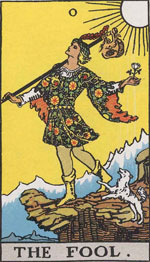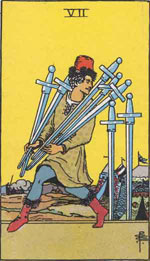 Here's a Fool from Lisle de Vaux Matthewman's Brevities (1903). Note that the fool is stepping on the tail of his animal companion. The caption reads, "Life may be a huge joke, but too often either the joke is not evident, or it is on us."
Here's a Fool from Lisle de Vaux Matthewman's Brevities (1903). Note that the fool is stepping on the tail of his animal companion. The caption reads, "Life may be a huge joke, but too often either the joke is not evident, or it is on us."
Sunday, May 31, 2009
Friday, May 29, 2009
 "Under criss-crossing overhead subway lines, old Japanese men in black velvet read fortunes at rickety tables by candlelight. I noted a chart of the palm at one spot, a tarot deck in another." -- Jennifer Dumpert
"Under criss-crossing overhead subway lines, old Japanese men in black velvet read fortunes at rickety tables by candlelight. I noted a chart of the palm at one spot, a tarot deck in another." -- Jennifer Dumpert
Thursday, May 28, 2009
 Demeter, the Greek Goddess of grain and fertility who according to myth taught humanity agriculture, is often associated with the Empress. It's interesting to compare the image of her above, taken from the 19th century work Dr. Vollmers Wörterbuch der Mythologie aller Völker, to the RWS Empress.
Demeter, the Greek Goddess of grain and fertility who according to myth taught humanity agriculture, is often associated with the Empress. It's interesting to compare the image of her above, taken from the 19th century work Dr. Vollmers Wörterbuch der Mythologie aller Völker, to the RWS Empress. The throne, scepter, and grain are elements present in both images. They communicate this archetype's dominion over growing things, and represent a figure who is both maternal and authoritative.
The throne, scepter, and grain are elements present in both images. They communicate this archetype's dominion over growing things, and represent a figure who is both maternal and authoritative. The Biblical figure of Samson is sometimes associated with the Strength card. He was, of course, renowned for his great strength, and like his Greek counterpart Hercules slew a lion. The image above is a 15th century engraving by E. S. Meister of Delilah cutting Samson's hair. By this act, she removed the source of his physical prowess. This depiction of a woman subduing a powerful man by the use of her feminine wiles makes for an interesting variation of the Strength card.
The Biblical figure of Samson is sometimes associated with the Strength card. He was, of course, renowned for his great strength, and like his Greek counterpart Hercules slew a lion. The image above is a 15th century engraving by E. S. Meister of Delilah cutting Samson's hair. By this act, she removed the source of his physical prowess. This depiction of a woman subduing a powerful man by the use of her feminine wiles makes for an interesting variation of the Strength card.
Monday, May 25, 2009
"scant mention was made of the Esther Scroll,
which is like a tarot containing ,
, 
 ,
,  , the
, the 
 ,
,  ,
, 
 , the
, the  ,
, 
which is like a tarot containing
 ,
, 
 ,
,  , the
, the 
 ,
,  ,
, 
 , the
, the  ,
, 
God is never named, and, in fact, there is no God in the tarot deck of cards. God plays his hand, and, some might dare to claim, He cheats."
****
Many thanks to Craig for providing the idea for this post.
 "Take Tarot cards. . . if you do readings. They should “speak” to you. If the images are dead and don’t get you creatively excited, find another deck that does!" -- Stuart Cumberland
"Take Tarot cards. . . if you do readings. They should “speak” to you. If the images are dead and don’t get you creatively excited, find another deck that does!" -- Stuart Cumberland(Thanks to Craig for inspiring this post. The above image is of the legendary Madame Lenormand, giving the Empress Josephine a reading.)
Sunday, May 24, 2009
 This detail from the Altarpiece of the Last Judgement by Rogier van der Weyden shows the Archangel Michael weighing souls. When I saw this image I thought it might be interesting to have a Tarot where all the Major Arcana explore the theme of balance. This image would be Judgment, naturally. The Magician could be portrayed juggling balls. The Fool could be shown at a crossroads, weighing his options. The Lovers would show a man deciding between two women. Death could be juxtaposed with a newborn, and so on.
This detail from the Altarpiece of the Last Judgement by Rogier van der Weyden shows the Archangel Michael weighing souls. When I saw this image I thought it might be interesting to have a Tarot where all the Major Arcana explore the theme of balance. This image would be Judgment, naturally. The Magician could be portrayed juggling balls. The Fool could be shown at a crossroads, weighing his options. The Lovers would show a man deciding between two women. Death could be juxtaposed with a newborn, and so on.
Saturday, May 23, 2009
AN EMILY DICKINSON TAROT REBUS
Because could not stop for
could not stop for 
He kindly stopped for me;
 held but just ourselves
held but just ourselves
And Immortality.
We slowly drove, he knew no haste,
And I had put away
My , and my
, and my  too,
too,
For his civility.
We passed the school, where strove
strove
At recess, in the ring;
We passed the fields of gazing ,
,
We passed the setting .
.
Or rather, he passed us;
The dews grew quivering and chill,
For only gossamer my ,
,
My tippet only tulle.
We paused before a that seemed
that seemed
A swelling of the ground;
The roof was scarcely visible,
The cornice but a mound.
Since then 'tis centuries, and yet each
Feels shorter than the day
I first surmised the horses' heads
Were toward .
.
Because
 could not stop for
could not stop for 
He kindly stopped for me;
 held but just ourselves
held but just ourselvesAnd Immortality.
We slowly drove, he knew no haste,
And I had put away
My
 , and my
, and my  too,
too,For his civility.
We passed the school, where
 strove
stroveAt recess, in the ring;
We passed the fields of gazing
 ,
,We passed the setting
 .
.Or rather, he passed us;
The dews grew quivering and chill,
For only gossamer my
 ,
,My tippet only tulle.
We paused before a
 that seemed
that seemedA swelling of the ground;
The roof was scarcely visible,
The cornice but a mound.
Since then 'tis centuries, and yet each
Feels shorter than the day
I first surmised the horses' heads
Were toward
 .
.Monday, May 18, 2009
Sunday, May 17, 2009
Wednesday, May 13, 2009

"To some extent you participated in putting a man on the moon, whether or not you had any connection at all with the physical occurrence itself. Your thoughts put a man on the moon as surely as any rocket did. You can become involved now in a new exploration, one in which man's civilizations and organizations change their course, reflecting his good intents and his ideals."
-- The Individual and the Nature of Mass Events
Jane Roberts
****
[Image from an 1872 Italian edition of Jules Verne's From the Earth to the Moon.]
Tuesday, May 12, 2009
 Continuing on the Triumphal theme, here is a 15th century depiction of the Triumph of Fame. In an interesting essay that appears in the Association for Tarot Studies newsletter titled Petrarch's Triumphs and the Creation of Tarot, Robert Mealing matches the Fame triumph with The World. I would match Fame with the Wheel of Fortune, since Fame, like Fortuna, can be fickle and fleeting, and someone can be famous one day and forgotten the next.
Continuing on the Triumphal theme, here is a 15th century depiction of the Triumph of Fame. In an interesting essay that appears in the Association for Tarot Studies newsletter titled Petrarch's Triumphs and the Creation of Tarot, Robert Mealing matches the Fame triumph with The World. I would match Fame with the Wheel of Fortune, since Fame, like Fortuna, can be fickle and fleeting, and someone can be famous one day and forgotten the next. Above is a lovely 2nd century Roman mosaic of a Triumph with Venus and Neptune. I immediately thought of the Lovers, of course.
Above is a lovely 2nd century Roman mosaic of a Triumph with Venus and Neptune. I immediately thought of the Lovers, of course.
Sunday, May 10, 2009
Saturday, May 9, 2009
 The is a Triumphal Chariot of the World, by late 16th century Flemish engraver Phillipp Galle. As best as I can tell, the two horses represent Day and Night. The ladies at the four corners appear to symbolize the four elements of fire, air, water, and earth.
The is a Triumphal Chariot of the World, by late 16th century Flemish engraver Phillipp Galle. As best as I can tell, the two horses represent Day and Night. The ladies at the four corners appear to symbolize the four elements of fire, air, water, and earth.I think it would be interesting to create a Tarot in which each trump is depicted as a chariot in a triumphal procession. This German website has more information on the image above.
Thursday, May 7, 2009
Sunday, May 3, 2009
Saturday, May 2, 2009

The Roman goddess Vesta, guardian of hearth and home, makes an interesting Queen of Coins; as deity of sacred fire, she suggests the alchemical process of smelting. (Vesta's priestesses, by the way, were the famous Vestal Virgins. They tended to the eternal flame at Vesta's temples.) On this coin, Vesta is shown seated on a throne. In the palm of her hand is the Palladium of Rome, a talismanic effigy of safety.
Subscribe to:
Posts (Atom)












